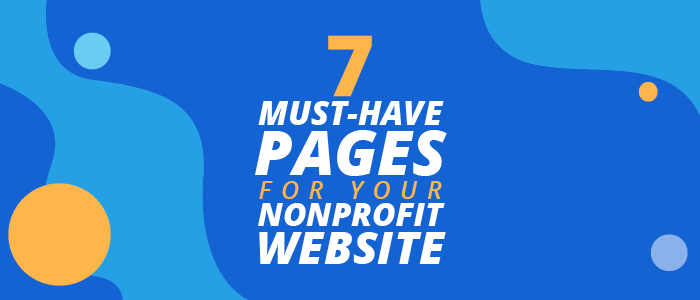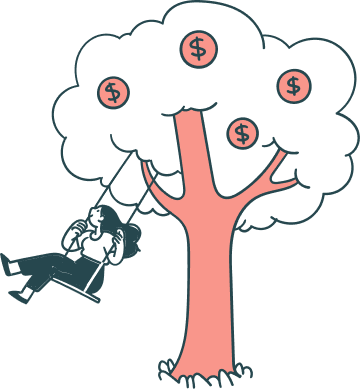Are you venturing into creating or redesigning a website for your nonprofit?
Designing a nonprofit website can be a challenge, but it doesn’t have to be overwhelming. Nonprofit web design looks a bit different from company and for-profit sites, so we put together seven essential pages for your website.
In this post, we’re going to take a deep dive into these must-have nonprofit webpages:
We’ve also included the latest website best practices and trends to guide you through this process.
1. Homepage
Your homepage is the first impression of your website. This is the page visitors will land on when they go directly to your site. The homepage is where you will share your most essential information concisely and visually. Here are our top tips for an impressive homepage.
Capture Visitors’ Attention
Strong visuals are crucial to grab the attention of new visitors. There are many types of media you can use to tell your organization’s story on your website. When designing your homepage, think of how you can integrate photos, videos, and infographics.
- Use high-quality images and videos. If you don’t have a budget to purchase photos or for a photographer, look into websites that provide free media, like Unsplash and Wave Video.
- Don’t overwhelm your site with too much media. Try using large and impactful images or videos.
- Be sure you have explicit permission when using images of real clients, volunteers, or donors.
Make Navigation Easy
You will have space in your header and footer to direct visitors to other parts of your website. You don’t want new visitors to be lost and unable to find the information they came to your site looking for.
- When organizing your navigation menu, start with broad themes, and use a drop menu if you have to. You don’t want to inundate your homepage and header with too many options.
- Don’t use jargon or abbreviations. Most visitors look for pages like “About” and “Contact,” so label those pages clearly.
Include Easy Calls-To-Action
What do you want visitors to do when they visit your website? Of course, you want them to learn about your organization, but what’s next?
Next steps of engagement may include becoming a donor, signing up to your email list, or following you on social media. These calls-to-action should be clear and easy to act on.
- Make your calls-to-action easy to find. You can make them stand out by making them larger, bolder, or a different color than other parts of your site’s navigation.
- Decide what the most important calls-to-action are. Try limiting to one or two on your homepage.
- Make the action descriptive and compelling. Instead of “Subscribe to Our Email List,” consider “Join Our Community.”
Visit the Rain Forest Trust for an example of a clear and compelling homepage. This site has a large, simple, and clear navigation. The homepage video is striking and drives home its mission. Their main
call-to-action is to donate, and so the donate button is very easy to find.
2. About
Once your visitors are inspired by your homepage, they will want to learn all about your organization. How did this all get started? Who are the people making this organization’s mission a reality?
The About section is where you will tell your nonprofit’s story. These sections are usually included on this page.
- Mission and values
- Organization history
- Milestones and achievements
- Leadership staff and board member profiles
- Donors and partners
Go to the World Science Festival’s website to view a well-done About section. The mission is clear and located at the top of the page. Right next to the mission is a video showing what the festival is all about.
The page continues with a description of what World Science Festival work entails a brief history of the organization. The page has links to the Founders & Staff page
and the Board of Directors page, which include interactive headshots and mini-bios.
3. Programs
If your organization provides a service, you will most definitely have potential clients and participants coming to your site to learn more. Keep these tips in mind while creating a program page.
- Don’t rely on too much text. Make program descriptions short and use images to convey program activities.
- Avoid jargon and be descriptive of what the program services are. Many programs, especially government-funded ones, are called things that are not intuitive. For example, instead of using the “Title IX Mentorship Program,” use “Women in Sports Mentorship Program.”
- Separate the kinds of programs you have, either through subheadings, visuals, or by linking out to a new page for each program.
- Make sure contact or enrollment information is easy to find.
- Include stories of impact. Share inspiring client and donor stories, compelling case studies, and quantify your impact.
The Roc Solid Foundation does an excellent job of showcasing their programs on their “What We Do” page. The page is organized simply and visually. You learn what the range of programs is with very
little text. Each program is linked to its own page to learn more.
4. Join Us
Some of your visitors will be psyched to learn about your mission and eager to get involved. The Join Us page will be the space where visitors can take part in your organization and cause.
Take time to think about all the ways a web visitor may become involved. Here are a few ideas.
- Donor
- Volunteer
- Member
- Advocate
- Email subscriber
- Social media follower
Just like with your program page, be sure to separate ways to get involved through text and visuals. Many of these options will include forms. Here’s what you need to keep in mind to create user-friendly forms.
- Logically group information you are requesting.
- Make forms one column, which is easier to read.
- Error notification should be clear on where the error is.
- Include a follow-up message or page that lets users know that the form went through.
Everytown for Gun Safety has several ways for web visitors to join their cause. Their Act page clearly and shows seven ways to get involved—both visually and using little text. The call-to-action buttons are urgent and motivating. Their most pressing ask is large and at top: to donate. In addition to advocacy-related ways to get involved, the email sign form
is right on the page, and social media icons are prominent.
5. Donate
When current and new supporters want to donate to your organization, they will go straight to your website. There are two key areas to focus on when creating your donation page — motivating copy and simple ways to give.
Write Compelling Copy
When writing copy for your donation page, make sure your reader’s central question is answered: “Why should I give to this nonprofit?”
Check off the following:
- Your mission is crystal clear.
- Donors know where their funds are going.
- Include your impact. You can do this through quantifying your reach, or sharing stories of real people impacted by your organization.
Make Online Donations Easy
Make sure the donation page is easy to find, and that making an online donation is seamless. Here are ways to make your online donation process easy.
- Have a prominent donate button in both your header and footer.
- Include a few ways that donors can give, including one-time donation, recurring or monthly donation, crowdfunding, campaigns, employer matching gifts, assets beneficiary, or stocks. Be sure each giving opportunity is clear.
- Make your donation form simple. Ask for the minimum amount of personal information that you need, like name, email address, payment info, and donation amount.
- Keep the donation process on your site. Most donation platforms allow you to brand the donation page to blend with the rest of your website seamlessly. Be sure the platform you choose includes this feature.
Children International has a model donation page. It conveys why donating to their organization is crucial for children in need with minimal words. If you are not convinced, it links a page explaining exactly where your donations will go. This page includes both impact data and the percentage of each contribution that goes straight to services. The donation form is simple and on-page instead of directing to a new page. The option to choose a one-time or monthly donation is right on the form. A link to numerous more giving opportunities is prominently included on top of the page.
If you want more tips for your donation page, read these 6 Steps to Create a Donation Website
for Your Nonprofit + 10 Great Examples.
6. News/Blog, Events, and Link to More Communications
When new visitors come to your site, give them the opportunity to stay up-to-date with your organization’s activities. This is typically done through blog and events pages and directing to other communications like social media and newsletters.
News and Blog Page
A blog or news page is the space to include important updates about your organization. Keeping up with a blog has many benefits for your website. Blogs increase traffic to your site, allow you to share updates quickly, and can help to establish your nonprofit as a thought leader in your field.
Here are a few ideas of blog posts you can write.
- Client stories
- Donor and volunteer stories
- Behind the scenes
- Industry news and insight
- Industry resources
- Q&A with expert staff
Events Page
If you hold events for the community or fundraising, you will want to include an events page. Here are a few ways to optimize this page.
- Have a calendar to show what is coming up soon visually.
- Make sure online registration and payments are on this page and easy to complete
- Include a past event photo gallery. This helps to create some buzz and excitement for future events.
Link to More Communications
Your website is an essential online communications channel. According to Funraise, social media and email are the second and third most effective fundraising and communications channels. Be sure you are connecting your website visitors to your other communications platforms.
- Include social media icons and an email sign-up form in your footer.
- Make a “Get Involved” page that encourages people to follow you on social media and subscribe to your email list.
- Prompt people to follow your channels on blog posts and other resources on your website.
That’s Not Cool is driven by their social media presence. Its website includes a “Social Hub” section to connect website users to other communications platforms. This page consists of a feed of all its social media channels and buttons to
social media pages on its sidebar.
7. Contact
No matter what your nonprofit does, a contact page is a must. Contact pages are typically one of the most visited site pages. Users should be able to get in touch with key staff in your organization easily.
Here are a few best practices for your contact page.
- Don’t hide this page. Make sure it is easy to find in your navigation.
- Instead of just one contact number, consider listing contact information for a few departments, like services, advocacy, press, donations, and human resources.
- If your organization has several sites, list contact information for each one.
- Provide a few ways to get in touch, including phone numbers, emails, and possibly address and fax.
- Consider using a contact form that directs messages to the right staff. Keep your contact forms simple.
Planned Parenthood has many different arms and sites across the country. Its contact page includes a main number, as well as specific numbers for specific departments, including press, donations, and job/volunteer opportunities. They also provide contact information listed for every Planned Parenthood site.
We hope your main take-away from this post is to keep your website simple and inspiring. Convey your mission and message visually and with minimal text. Ensure that all actions you want your web visitors to make are quick and easy.
If you have a game-plan for these fundamental web pages, you’re on track to design a website that will amplify your message and inspire new audiences to act.
Need more ideas? Here are 50 more nonprofit websites to get you inspired.

Sayana Izmailova is the Content Marketing Specialist at Wild Apricot, a membership management software. She has worked at a number of nonprofits and uses her experience to help small organizations advance their missions.



